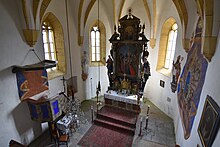Filial church St. Hemma am Kreuzberg
The Church of St. Hemma is a Roman Catholic branch church in the market town of Edelschrott in Styria . Its history goes back to the end of the 15th century.
Location
The church is located in the cadastral community of Kreuzberg , which belongs to the market town of Edelschrott , a scattered settlement between Edelschrott and Hirschegg . It is clearly visible from afar on a 1141 meter high ridge.
history
According to a legend, the church was founded by St. Hemma of Gurk in honor of the Mother of God . Its real origin can probably be found in the early mining activities in this area. The church was first mentioned in a document in 1498. The church may have been mentioned in another document as early as 1486. The current church building probably dates from around 1540 and was built on the site of an older chapel. The branch church was consecrated on October 18, 1551 by the Lavant Bishop Philipp Renner . In 1802 a porch was added to the church. Restoration work has recently taken place.
description
Today's single-nave church is a late Gothic building. On the outer walls in the apse area of the church there are strong, multi-stepped buttresses . In the west of the roof there is a roof turret with an onion helmet . Both the ridge and the church roof are covered with wooden shingles.
The three-bay nave has an apse with a three-eighth end. It is spanned by a ribbed vault resting on consoles . One of the consoles has a shield with a stonemason's mark. The tracery windows of the nave have two lanes. The baroque wooden gallery is located in the western part of the nave. To the west of the actual nave is a two-story, late-baroque porch from 1802. The sacristy extension with a Gothic portal is located south of the church.
The high altar, which was erected around 1650 and restored in 1857, shows the payment of the fair wages by St. Hemma , which supposedly took place at the current church location. The altarpiece shows a picture of the coronation of Mary . There are also statues of Saints Barbara and Rosalia on the high altar. The altar with the statue of St. Helena in the vestibule from around 1730/1740 comes from the Judenburg workshop of Balthasar Prandtstätter . The tabernacle , inlaid with silver, is dated to 1740. The simple pulpit was erected in the second half of the 17th century. To the right of the high altar is a niche with a painted, baroque baldachin, which was omitted in the 19th century, and a new seated statue of the Mother of God with child from around 1410 to 1420. The niche is surrounded by angels, who carry the instruments of Christ's passion . There is also a wall niche to the left of the high altar. In this there is a carved Mary's Lament with a Pietà , a kneeling Maria Magdalena and a standing angel. In the apse there are partially painted or damaged wall paintings of Saints Augustine and Nicholas .
The church furnishings include several church flags, one from 1707 with a representation of the high altar and a Pietà. Two smaller flags with depictions of Saint Hemma, Laurentius , Martin and the Mother of Grace from Mariazell date from 1721.
literature
- Federal Monuments Office (ed.): Dehio Steiermark (excluding Graz) . 2nd Edition. Berger, Horn / Vienna 2006, ISBN 3-85028-439-5 , p. 431-432 .
Individual evidence
- ↑ a b c d e St. Hemma branch church on the Kreuzberg. www.edelschrott.at, accessed on November 8, 2014 .
- ↑ a b c Federal Monuments Office (Ed.): Dehio Steiermark (excluding Graz) . 2nd Edition. Berger, Horn / Vienna 2006, ISBN 3-85028-439-5 , p. 431-432 .
Web links
Coordinates: 47 ° 1 '23 " N , 14 ° 59' 8.3" E


